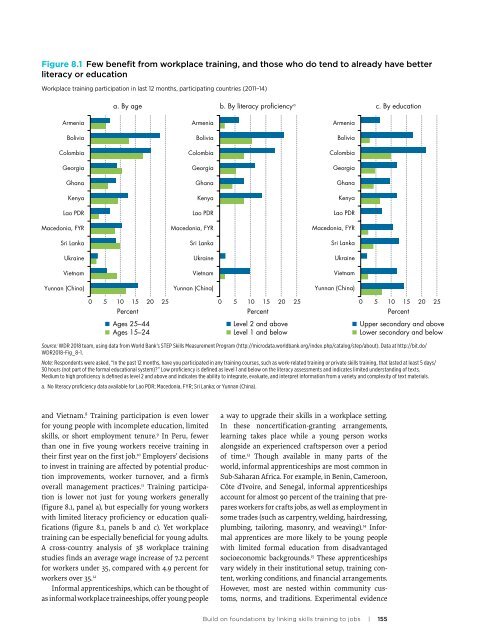Brasil só deve dominar Leitura em 260 anos, aponta estudo do Banco Mundial Relatorio Banco Mundial _Learning
You also want an ePaper? Increase the reach of your titles
YUMPU automatically turns print PDFs into web optimized ePapers that Google loves.
Figure 8.1 Few benefit from workplace training, and those who <strong>do</strong> tend to already have better<br />
literacy or education<br />
Workplace training participation in last 12 months, participating countries (2011–14)<br />
a. By age<br />
c. By education<br />
b. By literacy proficiency a Upper secondary and above<br />
Armenia<br />
Bolivia<br />
Colombia<br />
Georgia<br />
Ghana<br />
Kenya<br />
Lao PDR<br />
Mace<strong>do</strong>nia, FYR<br />
Sri Lanka<br />
Ukraine<br />
Vietnam<br />
Yunnan (China)<br />
Armenia<br />
Bolivia<br />
Colombia<br />
Georgia<br />
Ghana<br />
Kenya<br />
Lao PDR<br />
Mace<strong>do</strong>nia, FYR<br />
Sri Lanka<br />
Ukraine<br />
Vietnam<br />
Yunnan (China)<br />
Armenia<br />
Bolivia<br />
Colombia<br />
Georgia<br />
Ghana<br />
Kenya<br />
Lao PDR<br />
Mace<strong>do</strong>nia, FYR<br />
Sri Lanka<br />
Ukraine<br />
Vietnam<br />
Yunnan (China)<br />
0 5 10 15 20 25<br />
0 5 10 15 20 25<br />
0 5 10 15 20 25<br />
Percent Percent Percent<br />
Ages 25–44<br />
Ages 15–24<br />
Level 2 and above<br />
Level 1 and below<br />
Lower secondary and below<br />
Source: WDR 2018 team, using data from World Bank’s STEP Skills Measur<strong>em</strong>ent Program (http://microdata.worldbank.org/index.php/catalog/step/about). Data at http://bit.<strong>do</strong>/<br />
WDR2018-Fig_8-1.<br />
Note: Respondents were asked, “In the past 12 months, have you participated in any training courses, such as work-related training or private skills training, that lasted at least 5 days/<br />
30 hours (not part of the formal educational syst<strong>em</strong>)?” Low proficiency is defined as level 1 and below on the literacy assessments and indicates limited understanding of texts.<br />
Medium to high proficiency is defined as level 2 and above and indicates the ability to integrate, evaluate, and interpret information from a variety and complexity of text materials.<br />
a. No literacy proficiency data available for Lao PDR; Mace<strong>do</strong>nia, FYR; Sri Lanka; or Yunnan (China).<br />
and Vietnam. 8 Training participation is even lower<br />
for young people with incomplete education, limited<br />
skills, or short <strong>em</strong>ployment tenure. 9 In Peru, fewer<br />
than one in five young workers receive training in<br />
their first year on the first job. 10 Employers’ decisions<br />
to invest in training are affected by potential production<br />
improv<strong>em</strong>ents, worker turnover, and a firm’s<br />
overall manag<strong>em</strong>ent practices. 11 Training participation<br />
is lower not just for young workers generally<br />
(figure 8.1, panel a), but especially for young workers<br />
with limited literacy proficiency or education qualifications<br />
(figure 8.1, panels b and c). Yet workplace<br />
training can be especially beneficial for young adults.<br />
A cross-country analysis of 38 workplace training<br />
studies finds an average wage increase of 7.2 percent<br />
for workers under 35, compared with 4.9 percent for<br />
workers over 35. 12<br />
Informal apprenticeships, which can be thought of<br />
as informal workplace traineeships, offer young people<br />
a way to upgrade their skills in a workplace setting.<br />
In these noncertification-granting arrang<strong>em</strong>ents,<br />
learning takes place while a young person works<br />
alongside an experienced craftsperson over a period<br />
of time. 13 Though available in many parts of the<br />
world, informal apprenticeships are most common in<br />
Sub-Saharan Africa. For example, in Benin, Cameroon,<br />
Côte d’Ivoire, and Senegal, informal apprenticeships<br />
account for almost 90 percent of the training that prepares<br />
workers for crafts jobs, as well as <strong>em</strong>ployment in<br />
some trades (such as carpentry, welding, hairdressing,<br />
plumbing, tailoring, masonry, and weaving). 14 Informal<br />
apprentices are more likely to be young people<br />
with limited formal education from disadvantaged<br />
socioeconomic backgrounds. 15 These apprenticeships<br />
vary widely in their institutional setup, training content,<br />
working conditions, and financial arrang<strong>em</strong>ents.<br />
However, most are nested within community customs,<br />
norms, and traditions. Experimental evidence<br />
Build on foundations by linking skills training to jobs | 155








